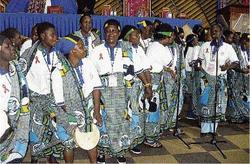Nashauna Drummond, Lifestyle Coordinator

Members of the Tanzanian delegation keep everyone well entertained prior to the official launch of the World YWCA International Women's summit at the Kenyatta International Confererence Centre in Nairobi, Kenya, on July 5, 2007. The theme for the summit was 'Women's Leadership on HIV and AIDS'. - photo by Nashauna Drummond
On Friday, December 1, the world celebrated the 9th World AIDS Day. With approximately 40 million persons infected with the virus worldwide, and millions of new infections occurring each year, this disease is the deadliest that has ever affected the human race.
More than half the number of those infected are women. This year, Flair, the leading women's magazine in Jamaica, begins its new series; The Feminisation of HIV/AIDS. Every first and third Monday of each month, we will examine the plight of women affected by the disease and the power of women in their fight against it.
WOMEN IN An HIV WORLD
In July last year, the largest gathering of women focusing on HIV/AIDS took place at the Women's Summit in the context of the World YWCA World council in Nairobi, Kenya. Under the theme: 'Women's leadership in the fight against HIV/AIDS', it brought together positive living women, U.N. agencies, members of the Church and all associated parties to discuss the role of women in the fight against the disease, the recurring obstacle that they face and the way forward.
Newly infected persons
UNAIDS estimates that there are 39.5 million people living with the virus. More than half of that number are women. In the Caribbean, there is an estimated 330,000 persons living with the virus with 37,000 new infections in 2005. In 2007, 17,000 persons were newly affected with the virus in the Caribbean.
According to Jamaica's National AIDS Programme website, of the 1,186 persons with AIDS or advanced HIV in 2006, 659 were males and 527 were female.
Women most at risk are those who have a history of sexual abuse, poverty, violence, or limited educational and economic opportunities.
HIV-prevention campaigns need to utilise prevention education that is gender-sensitive and rights-based approaches, as other factors such as sexual and domestic violence also play a role in female vulnerability to the virus. There are many issues that contribute to the increasing number of infected females. Socially defined gender roles and stereotypes limit a woman's social and economic power and her right to healthy relationships.
Whether you're infected or affected, if you have a concern or story to tell email: nashauna.drummond@ gleanerjm.com, lifestyle@ gleanerjm.com or send letter to Flair, The Gleaner Company, 7 North Street.
Sources: http://data.unaids.org/pub/GlobalReport/2006/200605-FS_globalfactsfigures_en.pdf. And http://www.jamaica-nap.org/aids_d.html

